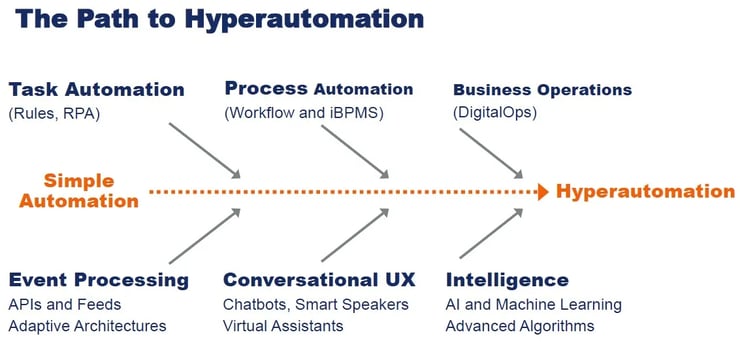Introduction to Hyperautomation
.png) by
Raul Ramirez
by
Raul Ramirez
In recent years, automation has become increasingly important for businesses seeking to undergo digital transformation. Automation is used in various areas such as fraud detection, cybersecurity, marketing, and even the development of artificial intelligence. As a way to increase productivity, reduce costs, and improve efficiency, companies from various industries are exploring the next step in automation, known as hyperautomation
WHAT IS HYPERAUTOMATION?
Hyperautomation is the use of advanced technologies, such as artificial intelligence (AI) and machine learning (ML), to automate processes and tasks. It is a way to streamline business operations and increase efficiency by replacing manual work with automated processes.
Hyperautomation can be applied to a wide range of industries and functions, including customer service, finance, HR, and marketing. It allows companies to reduce their reliance on human labor and lower costs, while also improving the accuracy and speed of their processes.
One of the key technologies used in hyperautomation is robotic process automation (RPA), which involves using software bots to perform tasks that are typically done by humans. RPA bots can handle repetitive, rule-based tasks, such as data entry and document processing, freeing up human workers to focus on more complex and creative tasks.
Another key technology in hyperautomation is AI, which can analyze data, identify patterns, and make decisions on its own. This can be used to automate tasks such as analyzing customer data to identify trends and make recommendations, or to optimize supply chain management.
Hyperautomation also involves the integration of various technologies and tools, such as workflow automation software and process mining tools, to create a comprehensive system for automating processes.

HOW DOES HYPERAUTOMATION DIFFER FROM AUTOMATION?
Automation streamlines repetitive tasks, reducing the need for human intervention, while hyperautomation takes it a step further by adding advanced technology and intelligence to the process. This allows businesses to not only automate manual workflows, but also extract value from them. In other words, hyperautomation scales on automation and amplifies its capabilities, building a process that is constantly advancing and improving through data. By adding intelligence to automation, this combination offers the horsepower and flexibility to automate the toughest processes – including undocumented operations that depend on unstructured information. This enables enterprises to address customer expectations quickly, fulfill business goals, improve productivity, and boost efficiency.
WHAT ARE THE BENEFITS OF HYPERAUTOMATION?
As noted above, hyperautomation extends core automation and RPA with advanced technologies such as AI and machine learning.
Some of the benefits of hyperautomation include:
- Reduce costs by using digital technologies to automate tasks that are otherwise repeatable tasks requiring manual intervention.
- Increase business agility by providing quicker, richer insights for more accurate decision-making.
- Accelerate the innovation lifecycle to produce products and services of higher quality with faster time to market by leveraging more intelligence, improved consistency and reduced human error.
- Improve customer experiences (CX) by handling repetitive time-consuming work, enabling employees to fully focus on building enduring customer relationships.
Hyperautomation is especially advantageous for businesses with legacy systems or low automation levels. These organizations can see real results through digital process automation and infrastructure automation to increase connectivity, agility or efficiency of business operations.
BOTTOM LINE
Gartner predicts that by 2024, organizations will lower operational costs by 30% by leveraging hyperautomation across their end-to-end value chain. A word of caution: hyperautomation isn’t just a checklist item on an organization’s technology roadmap. It needs to become a part of the enterprise DNA for it to work most effectively. A “hyperautomation first” strategy needs to be an enterprise keystone, with confidence building in the systems to which it is applied to foster acceptance and drive culture change.
Remember that people, technology and business processes need to be aligned for a unified and strong cultural change to emerge. Top management must pay particular attention to supporting the people/role leg of the hyperautomation triad in order to have trickle-down effects across the organization. They must motivate teams to embrace automation, incentivising and rewarding that work, and help them understand that automation isn’t something that will replace their jobs, a perception that has been around since the industrial revolution. Organizations must be truthful when they announce that their goal is to upskill employees, which will help decrease resistance to change. This transition must happen in line with people’s own aspirations and goals, too — the human connection is critical.
Hyperautomation not only gives a powerful, unified and systematic end-to-end experience that is agile and quickly adaptable, but it also helps enterprises gain competitive advantages.
